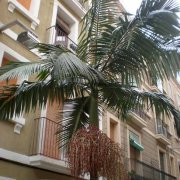Care of the palm tree Roystonea regia or Cuban palm |
|
The Roystonea genus, Arecaceae family, comprises 10 species of palm trees native to Central America, the Caribbean, Florida, Colombia and Venezuela. Some species are: Roystonea regia, Roystonea oleracea, Roystonea altissima, Roystonea violacea. Common names: Cuban palm, Bottle plant, Royal palm, Cuban royal palm, Florida royal palm. This species is native to Cuba, Florida and the Caribbean. They are large palm trees with a greyish trunk at the bottom and an intense green color at the top, reaching 25 meters (82 feet) in height. The arched leaves are composed of leaflets and are 6 meters (19.68 feet) long. They produce cream-colored male and female flowers that are not decorative. The spherical red or purple fruits are quite decorative. This fast-growing palm is used in streets, public parks, as isolated specimens or in small groups in the garden. Cuban palm is ideal for gardens by the sea. Roystonea regia needs full sun exposure and warm climates. It's a tropical plant that does not resist cold below 8 ºC (46.4 ºF). The soil must drain very well and contain a lot of organic matter. Planting is done during the first half of spring. Royal palm is quite resistant to drought but in summer it prefers regular watering, waiting for the substrate to be almost dry. Fertilize in spring with mineral fertilizer and compost every 3 months in spring and summer. Cuban royal palm does not need pruning. Roystonea regia does not usually present significant pest and disease problems. Florida royal palm is propagated from seeds sown in spring in the nursery; they can germinate in 1-2 months. |
Images of the palm tree Roystonea regia or Cuban palm |
Find plants
Roystonea regia or Cuban palm | Care and Growing
© 2025 FavThemes





